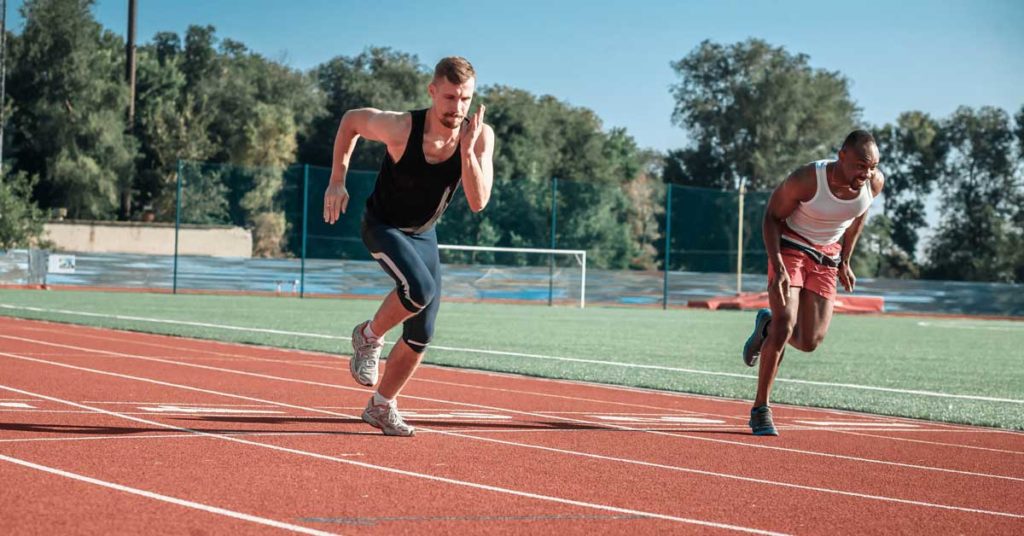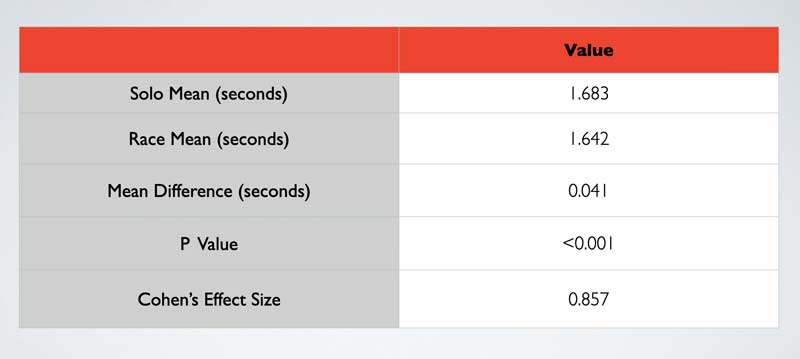
Intuition would probably tell you that athletes are faster when they race. Makes sense, right? It’s competition, they have motivation, it turns their brain off so they can just sprint. But my analytical brain wanted to know if that was actually true. We can scientifically answer that question with sport science and the scientific method, in addition to using our coaching intuition.
From a coaching standpoint, we are always trying to draw more effort out of our athletes to run harder and faster. However, as coaches coach more and athletes learn more, too many drills and cues can potentially slow down full-speed sprinting in training. Thus, it’s important to bridge the gap between training and games. But how do we replicate game speed (literally and figuratively) in training?
Sports are played in competition and sports are played fast. In training, although things need to be slowed down and emphasized to improve things like technique, we can’t forget about the true end goal. Racing serves a purpose to bring the technique and drill work full circle, create a fun and engaging training environment, and draw out some pretty fast times. But what is the effect of racing on sprint times? Effort might be up, engagement might be up, but does racing actually make athletes faster?
What is the effect of racing on sprint times? Effort might be up, engagement might be up, but does racing actually make athletes faster, asks @CoachBigToe. Share on XSport science is simply just applying the scientific method to getting better at sport. The scientific method is:
- Ask a question/create a hypothesis.
- Collect your data.
- Analyze the data.
- Figure out what the data means.
- Apply it to the real world.
That’s just what I did to answer my racing question, and I’m here to explain my process.
Methods
Although this is a personal and informal case study, it’s still important to get the highest quality data possible. As they say: garbage [data] in, garbage [data] out. Having gone through the entire process of starting, finishing, and publishing my thesis in the Journal of Strength and Conditioning Research not too long before doing this case study, my research brain kicked into gear. Here’s everything I did (especially things I did NOT do) to control for the confounding variables:
- I kept my instructions and general words to a minimum. The instructions followed something like this: “We’re going to do four timed sprints: two are by yourself and two are racing against someone else. Walk back in between. I’ll tell you whether you’re going by yourself or racing when it’s your turn. If you’re racing but not being timed, you’ll run next to them but outside the timing lasers.”
- I didn’t share my research question, hypothesis, or anything pertaining to my motive for the experiment. I didn’t want my athletes knowing that I was comparing and contrasting the two types of sprints to artificially draw out more effort during the race. One might be able to assume my intentions and guess the purpose based on my instructions, but at least it wasn’t my explicit words that influenced their motivation.
- I didn’t coach in-between sprints, as I didn’t want a cue that they didn’t have the sprint prior to improve a sprint time.
- I didn’t let any athlete see the sprint times. I didn’t want an athlete to become motivated by seeing a slower sprint time than what they are used to or expected. They tried peeking over my shoulder, but don’t worry, I had my head on a swivel.
- I paired up my athletes with someone of a similar speed. If there was a big discrepancy in speed between athletes, this could’ve led to a lack of effort by the slower athlete. If there was not an athlete of similar speed, I gave the athlete not being timed during the race a head start if they were slower or made them start a few steps behind if they were faster. It’s not a perfect science, but that’s how I would handle a discrepancy in speed during a normal session.
- Collecting this data over multiple training sessions with multiple groups of athletes, I alternated between one group doing their solo sprints first and the next group doing their races first. This minimized two things: the sprints at the beginning acting more like a warm-up and making the sprints at the end faster, and the sprints at the end being slower due to excessive fatigue from the prior sprints.
- I was intentional about the rest periods. Although it wasn’t perfect, I did time the rest of the first person in each group to make sure they had at least two minutes of rest.
Athletes
Twenty-two athletes (n=22: 8 youth (9-11 years old), 11 middle school (12-14 years old), 3 high school (15-18 years old)) participated in speed and agility training sessions coached by me and had been attending for multiple weeks.
Data Collection and Analysis
After a full warm-up and a pre-data-collection sprint, they ran 5-15’s. A 5-15 is an acceleration test that’s 15 yards in length with the timing lasers set up on the 5- and 15-yard lines, respectively. Each athlete performed two 5-15’s solo (by themselves), instructed to run as fast as possible. Each athlete also performed two 5-15’s against another athlete. The races were started verbally by me saying “Ready, go!” The two sprints for each condition were averaged to give each athlete one time for solo and one time for racing. Solo times and racing times were then run in a paired samples T-test in jamovi.

Statistics Made Simple
A “p value” of < 0.001 means that less than 0.1% of the time, the difference between solo sprints and races happened by chance, or greater than 99.9% of the time the difference was actually there.
A “Cohen’s Effect Size” of 0.857 means that the magnitude or size of the difference between solo sprints and races was large (as opposed to medium or small).
The combination of these two stats means that the difference between the solo and the race (2.4% faster) wasn’t by chance, and it was a large difference.
Conclusions
Athletes sprint 2.4% faster when motivated by racing. Racing provides another tool in a coach’s toolbox to get faster training reps from their athletes. It’s a perfect option to help bridge the gap between controlled drills focused on technique and the true end goal of training being fast at game speed.
Racing is a perfect option to help bridge the gap between controlled drills focused on technique and the true end goal of training being fast at game speed, says @CoachBigToe. Share on XUltimately, because no one gets faster overnight, and we’re playing the long game in speed development, intentionally making athletes race will add up over time. Let’s say of your timed sprints during a training session, half of them are solo sprints and half of them are races. You just improved the output of 50% of your athlete’s training reps. Now add that up over the course of multiple months of training—that’d be a big difference in the stimulus given to your athletes. Sounds like an interesting and practical option to me.
Future Considerations
Although this makes sense in theory and the numbers make sense, there is some context and other factors worth mentioning.
- Races might not have same effect with older athletes who truly know how to sprint at max effort regardless of solo sprint or race. Considering 19 of my 22 athletes were ages 9 to 14, the numbers might’ve been a little different if there were more high school athletes.
- Technique sometimes decreased when they were just thinking about winning. Athletes sometimes tried reaching for the laser with their hand to “win” (those times weren’t recorded). It’s important to remind them to not let the finish line influence their technique.
- The number of athletes in a training session is an important factor. With larger groups, racing is a great option to keep more athletes moving and minimize the standing around. However, with smaller groups, rest times should be kept in mind since athletes sprint twice as frequently when racing.
Practical Applications
Races should be programmed during speed training for at least multiple reps at the end of a session. Although technique might slightly decrease, speed increases, and at the end of the day, that’s what we’re training for. A 50/50 approach of solo sprints to races might be effective in getting those quality, coaching-intensive reps in at the beginning then putting it all together at the end.
Since you’re here…
…we have a small favor to ask. More people are reading SimpliFaster than ever, and each week we bring you compelling content from coaches, sport scientists, and physiotherapists who are devoted to building better athletes. Please take a moment to share the articles on social media, engage the authors with questions and comments below, and link to articles when appropriate if you have a blog or participate on forums of related topics. — SF


how could I simulate race condition to get the maximum speed out of a workout.